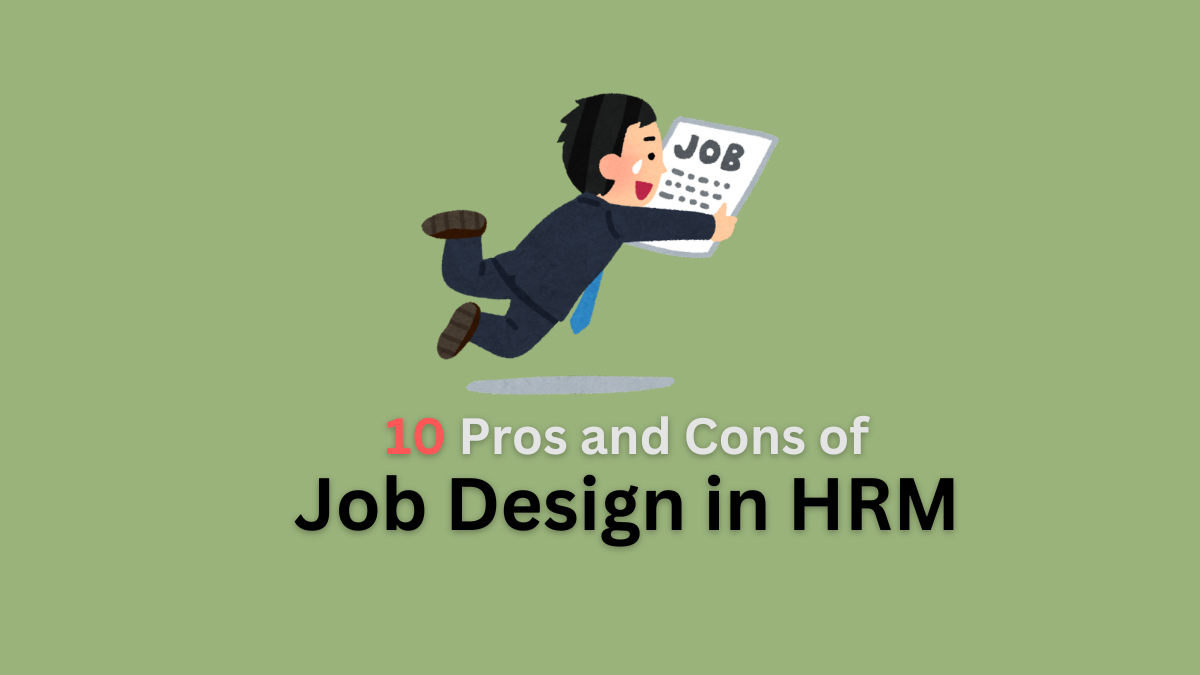Pros and Cons of Job Design
Job design, also known as work design or task design, is a fundamental aspect of human resource management. It involves outlining the contents, methods, and relationships of jobs to meet technological and organizational needs while satisfying the social and personal requirements of employees.
Here we will discuss the 10 major pros and cons of job design in HRM, so let’s get started:
Pros of Job Design
Below are the five major benefits of job design in HRM:
Increased Employee Motivation and Satisfaction
One of the primary advantages of job design is that it enhances employee motivation and satisfaction. By creating job roles that are engaging and rewarding, employees are more likely to feel a sense of accomplishment and fulfillment.
This is achieved through methods like job enrichment and job enlargement, which add variety and significance to their daily tasks. When employees find their work meaningful and feel that their contributions are valued, they are more motivated to perform well and stay committed to their organization.
Enhanced Skill Development
Job design can significantly contribute to the development of an employee’s skill set. Through job rotation, employees are exposed to different roles and responsibilities, which broadens their expertise and capabilities.
This cross-training helps employees gain a comprehensive understanding of various functions within the organization, making them more versatile and valuable. This skill development is beneficial not only for the employees, who can advance their careers but also for the organization, which gains a more competent and adaptable workforce.
Improved Productivity and Efficiency
Effective job design aligns tasks and responsibilities with the organization’s goals, leading to improved productivity and efficiency. By streamlining roles through methods like job simplification, tasks are made more manageable and processes more efficient.
This reduction in complexity allows employees to focus on their core tasks without unnecessary distractions, thereby enhancing their performance and output. Additionally, well-designed jobs can minimize fatigue and errors, further boosting overall productivity.
Better Work-Life Balance
Job design can incorporate elements that promote a healthier work-life balance for employees. This includes flexible work arrangements, such as remote work options, adjustable working hours, and adequate vacation time.
Read More: 10 Major Pros and Cons of SWOT Analysis
By acknowledging and accommodating the personal needs of employees, organizations can help reduce stress and burnout. A balanced work-life integration not only improves employee well-being but also leads to higher job satisfaction and loyalty, reducing turnover rates.
Higher Quality of Work
When employees have a clear understanding of their roles and receive regular feedback, they are more likely to produce higher-quality work. Job design emphasizes providing clear expectations and constructive feedback, which helps employees understand the impact of their work and strive for excellence.
Methods like job enrichment, which add responsibility and decision-making power, encourage employees to take ownership of their tasks and produce work that meets or exceeds the organization’s standards.
Read More: 10 Major Pros and Cons of Planning
Cons of Job Design
There are also some drawbacks of job design – below are five to mention:
Risk of Monotony and Boredom
One of the significant disadvantages of job design, particularly job simplification, is the risk of monotony and boredom. When tasks are overly simplified and repetitive, employees may quickly lose interest and engagement.
This lack of stimulation can lead to decreased motivation and lower job satisfaction, potentially resulting in higher absenteeism and turnover rates.
Potential for Increased Workload and Stress
Job enlargement, while beneficial for skill development, can sometimes lead to an increased workload that may overwhelm employees.
Read More: 10 Major Pros and Cons of Participative Management
Adding more tasks to an existing role without adequate support or resources can create stress and reduce overall efficiency. Employees may struggle to balance additional responsibilities, leading to burnout and a decline in performance.
Disruption of Workflow
Job rotation, although useful for broadening skills, can disrupt the workflow and affect the continuity of tasks.
Frequent rotation may prevent employees from fully settling into a role or developing deep expertise in a specific area. This disruption can lead to temporary declines in productivity and quality of work as employees adjust to new responsibilities.
Read More: 10 Major Pros and Cons of Outsourcing
Conflict and Power Imbalance
Job enrichment, which involves adding more responsibilities and decision-making powers, can sometimes create conflicts and power imbalances within the team.
Senior employees given more control may dominate decision-making processes, leading to potential disputes with lower-level staff. This power dynamic can create tension and reduce team cohesion and collaboration.
Loss of Focus on Core Competencies
Job enlargement can sometimes cause employees to lose focus on their core competencies. By spreading their attention across a broader range of tasks, employees may struggle to excel in any particular area.
This dilution of focus can negatively impact the quality of work and reduce overall effectiveness. It is essential to balance the addition of new tasks with the maintenance of core responsibilities to avoid this pitfall.
Hence, these are the 10 major pros and cons of job design in the workplace or HRM.
Read Next: 10 Major Pros and Cons of Business Ethics
